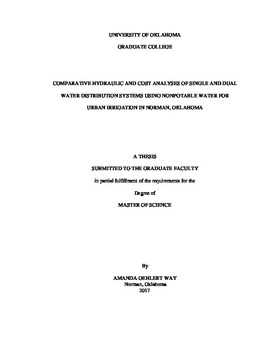| dc.description.abstract | Drought has caused water resource shortages throughout Western and Midwestern United States for many years, particularly in California, Nevada, Arizona, Texas, and Oklahoma. This has led many communities to evaluate alternate water sources, including water reuse and raw water for nonpotable uses. Commonly, reuse water is used for commercial or industrial uses, such as irrigating golf courses or providing cooling water in factories. However, water reuse and nonpotable water have rarely been evaluated for residential and commercial landscape irrigation (urban irrigation), exceptions being St. Petersburg, Florida and Rouse Hill, Australia. This is mainly attributed to the small scale of these users, the complexity of serving many users, and concern about cross contamination on a large scale; urban irrigation, however, can account for the majority of a community’s water use during the summer and almost a third of the water use during spring and fall months. This research project uses hydraulic models to simulate using nonpotable water for urban irrigation in Norman, Oklahoma, with effluent from the Norman Water Reclamation Facility and nonpotable water from wells that do not meet the EPA Arsenic Rule. The hydraulics and costs are compared for a hypothetical dual distribution system with the existing single distribution system. The research also evaluates how reducing the potable demand affects the need for Norman to find additional water sources by 2062. The cost comparison includes developing new water sources, construction costs for increasing treatment capacity for the single and potable systems and installing a secondary distribution system, and operations and maintenance costs for the single and dual distribution systems. The results found that utilizing existing water resources (e.g., wastewater effluent and nonpotable wells) and installing a secondary distribution system to provide nonpotable water for a limited service area can ultimately be more cost-effective than developing new water sources to supply the 2062 water demands for Norman. Ultimately, this project found that constructing a secondary water distribution network can be a cost-effective alternative to help reduce demands on the existing water distribution system and a way to improve reliability of the potable distribution system. | en_US |
